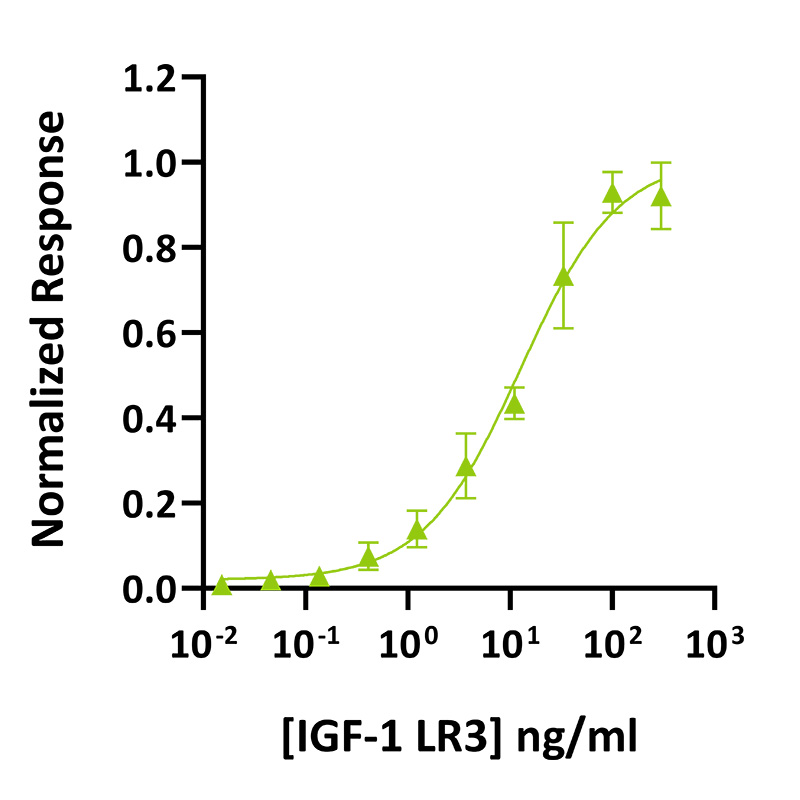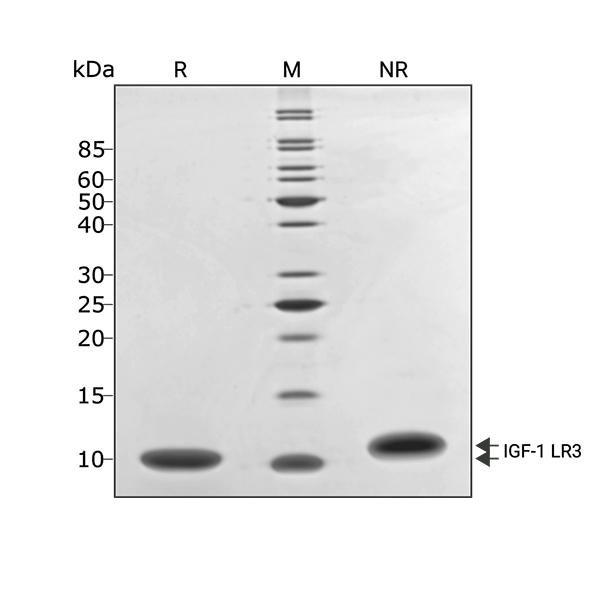 Recombinant human IGF-1 LR3 protein (Qk041)
Recombinant human IGF-1 LR3 protein (Qk041)Recombinant human IGF-1 LR3 protein (Qk041)
£60.00 – £190.00

Human insulin-like growth factor 1 long arginine 3 (IGF-1 LR3) protein is a synthetic analog of IGF-1. The substitutions include an arginine substitution and an N-terminal protein extension. Consequently, IGF-1 LR3 has improved biological potency and extended half-life. IGF-1 LR3 can be used for the consistent, reproducible maintenance of human pluripotent stem cells.
Qkine IGF-1 LR3 is a highly pure and bioactive 9 kDa protein monomer, animal origin-free (AOF) and carrier-protein free (CF).
In stock
Orders are typically shipped same or next day (except Friday).
Easy world-wide ordering, direct or through our distributors.
£60.00 – £190.00
Fast and free shipping.
Buy online with secure credit card or purchase order. For any questions, please email orders@qkine.com
Summary:
- High purity human IGF-1 LR3 protein (Uniprot: P05019 for IGF-1 wild-type protein)
- 9 kDa
>98%, by SDS-PAGE quantitative densitometry
Expressed in E. coli
Animal origin-free (AOF) and carrier protein-free
Manufactured in our Cambridge, UK laboratories
Lyophilized from acetonitrile, TFA
- Resuspend in sterile-filtered water at >50 µg/ml, add carrier protein if desired, prepare single use aliquots and store frozen at -20 °C (short-term) or -80 °C (long-term).
Featured applications:
Maintenance of pluripotency in iPSC
Cell culture media optimization and replacement of insulin in defined media

IGF-1 LR3 activity was determined using the Promega serum response element luciferase reporter assay in transfected MCF-7 cells. Cells were treated in triplicate with a serial dilution of IGF-1 LR3 for 4 hours. Firefly luciferase activity was measured and normalized to the control Renilla luciferase activity. Data from Qk041 lot #104470. EC50 12.7 ng/ml (1.4 nM).
IGF-1 LR3 migrates as a single band at 10 kDa in non-reducing (NR) conditions and upon reduction (R). No contaminating protein bands are visible. Purified recombinant protein (3 µg) was resolved using 18% w/v SDS-PAGE in reduced (+β-mercaptothanol, R) and non-reduced (NR) conditions and stained with Coomassie Brilliant Blue R250. Data from Qk041 batch #104315.

Further quality assays
Mass spectrometry: single species with expected mass
Recovery from stock vial: >95%
Endotoxin: <0.005 EU/μg protein (below level of detection)
We are a company founded and run by scientists to provide a service and support innovation in stem cell biology and regenerative medicine. All our products are exceptionally high purity, with complete characterisation and bioactivity analysis on every lot.

Qkine IGF-1 LR3 remained bioactive in media for 7 days. Bioactivity was determined using an IGF-1-responsive firefly luciferase reporter assay. Transfected HEK293T cells were treated in triplicate for 4 hours with a serial dilution of IGF-1 LR3 which had been pre-incubated in conditioned media for 7 days. Firefly luciferase activity was measured and normalised to the control Renilla luciferase activity.
Protein background
The insulin-like growth factors (IGFs) are a family of proteins with a similar structure to insulin. IGF-1 has an A and B chain connected by disulphide bonds, its similarity to insulin means it can bind with low affinity to the insulin receptor [1]. IGF-1 is a primary mediator of growth hormone (GH), with growth-promoting effects on most cells and tissues including skeletal muscle, cartilage, bone, liver, kidney, nerve, skin, hematopoietic, and lung [1]. IGF-1 exerts its biological effect through binding to the IGF1 receptor (IGF1R), its effect is modulated through interaction with a group of binding proteins (IGFBPs), which tend to inhibit the effect of IGF-1 [2]. Through IGF1R the Ras-MAPK and PI3 kinase signaling pathways are activated leading to increased cell proliferation and survival [2].
IGF-1 can be used to support maintenance of human embryonic stem cell (ESC) [3] and mesenchymal stem cell (MSC) cultures [3, 4].
Insulin-like growth factor long arginine 3 (IGF-1 LR3), is a widely used synthetic analog of IGF-1 with an arginine replacing glutamic acid at position 3 (arginine 3, R3), and an additional 13 amino acids at its N-terminus (long, L). IGF-1 LR3 retains the ability to bind IGF-1 and insulin receptors but has reduced binding affinity to insulin-like growth factor-binding proteins (IGFBPs). Consequently, IGF-1 LR3 has improved potency and metabolic stability [5].
Additional resources
FAQ
IGF-1 LR3 is a modified form of IGF-1, it is more potent and stable than unmodified IGF-1.
IGF-1 LR3 is a synthetic protein and not naturally occurring.
IGF-1 LR3 has an arginine instead of a glutamic acid at the third position in its amino acid sequence and an additional 13 amino acids at its N-terminus. IGF-1 LR3 remains an agonist of the IGF-1 receptor, but it has very low affinity for IGFBPs, which inhibit IGF-1, making it more potent. IGF-1 LR3 also has a significantly longer half-life than IGF-1.
IGF-1 LR3 binds to the IGF-1 receptor (IGF1R).
IGF1R is linked to various cytoplasmic second messenger molecules including the RAS-MAPK and PI3K signaling networks.
IGF-1 LR3 can be used to replace IGF-1 in stem cell cultures. Increased potency and stability means less IGF-1 LR3 is needed compared to unmodified IGF-1.
Our products are for research use only and not for diagnostic or therapeutic use. Products are not for resale.

Receive an Amazon gift voucher when you leave us a review.
£25, $30 or €30 for reviews with an image and £10, $15 or €15 for reviews without an image